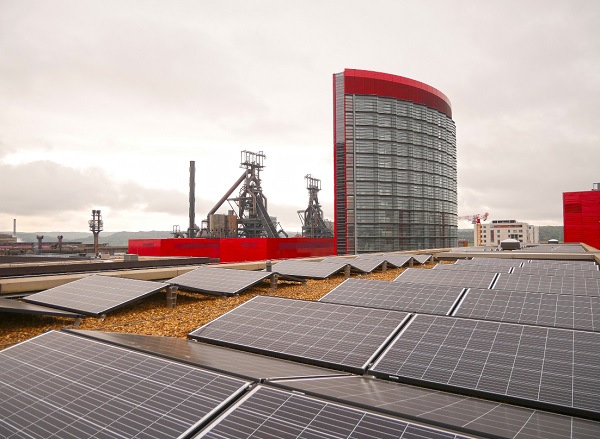 Credit: Fonds Belval
Credit: Fonds Belval
Luxembourg's Minister for Mobility and Public Works François Bausch, accompanied by Luc Dhamen, Director of the Belval Fund, visited on Monday the photovoltaic installation of the Maison des Sciences Humaines, the third of five public buildings in Esch-Belval to eventually be equipped with such facilities.
After the Rockhal in 2018 and the Maison de l'Innovation in 2019, the Maison des Sciences Humaines has been equipped with an installation for producing electricity from solar energy, the deployment of which is part of the concrete application of the objectives emanating from the Rifkin study in terms of reducing energy consumption and increasing national production of energy from renewable energies.
This is also one of the objectives set by the European Union, as part of its energy project, which foresees that Europe will become a sustainable economy, respectful of the environment and carbon neutral. It is expected to play a pioneering role in the production of renewable energy as well as in the fight against global warming.
One of the main ways to increase national energy production is by increasing the production of electrical energy through photovoltaic installations. The Belval Fund is continuing to implement the measures initiated by the government in favour of the production of renewable energies in public buildings, allowing the reduction of carbon emissions and the supply of clean energy.
The photovoltaic installation on the roof of the Maison des Sciences Humaines consists of 610 solar panels of 330 Wp (watt-peak), reaching a total installed power of over 200 kW (kilowatts). The annual electricity consumption of the Maison des Sciences Humaines is approximately 1,200,000 kWh (kilowatt-hours). With an annual electricity production of 175,000 kilowatt-hours / year, i.e. the equivalent of an annual production covering the needs of some 40 single-family homes, the photovoltaic installation will cover around 15% of the electricity needs of the building and save 113 tonnes of CO2 per year. The amount of the investment is €420,000 including tax.
The Mobility Minister and Luc Dhamen also visited the photovoltaic installation of the Maison de l'Innovation, operational since September 2019. The installation features 565 flat-positioned solar panels, reinforced by a thicker glass panel, on which it is possible to walk, for maintenance or cleaning. The amount of investment was approximately €875,000 including tax.
The first public building in Belval to have been fitted with a photovoltaic installation was the Rockhal. The installation, operational since 2018, is made up of 2,300 panels that produce annual electricity of 570,000 kWh and reduce CO2 emissions by 370 tonnes / year. The annual production of photovoltaic panels represents approximately 60% of the building's electrical energy needs. The photovoltaic installation was notably rewarded with a mention at the Bauhärepräis OAI 2020, in the category "technical, energy equipment".
On the Belval site, five public buildings had potential for the installation of photovoltaic installations: the Rockhal, the Lycée Bel-Val, the Maison du Savoir, the Maison des Sciences Humaines and the Maison de l'Innovation. Three of the five buildings are now equipped with such facilities.
The total power of the solar installations in the buildings of the Maison des Sciences Humaines, the Maison de l'Innovation and the Rockhal combined, reaches approximately 1,030 kilowatts. Once the five buildings are equipped, the annual electricity production of the Cité des Sciences will approach 2 million kWh / a, thus reducing CO2 emissions by around 1,250 tonnes / year, for a total investment of around €5 million. The five photovoltaic installations are financed by the climate and energy fund set up by the government.
In the new construction projects of the Belval Fund, sustainability and energy efficiency criteria play a predominant role, from the first planning phase; these projects will automatically integrate installations and equipment using natural and renewable energies. This is the case, for example, for the future National Archives building which will also be the first positive energy building in Belval.








